Every organization wants to perform at its best. However, many need help with a common challenge: misaligned goals and unclear performance reviews.
When individual goals don’t align with the company’s broader objectives, tracking progress becomes difficult, and performance often suffers. This is where OKRs (Objectives and Key Results) come in, providing a clear and robust framework to bridge this gap.
According to Gartner’s research, creating work environments focusing on people first leads to impressive results. Organizations with human-centric practices are 3.8 times more likely to see high employee performance, 3.2 times more likely to retain employees, and 3.1 times more likely to experience lower fatigue.
Companies see better engagement, increased motivation, and improved results by putting employees first and building flexible models that adapt over time.
But how exactly do OKRs influence performance management and employee engagement? And how do they link individual goals to larger organizational outcomes? Let’s explore this in more detail.
OKRs are the Key to Aligning Goals and Performance
OKRs stand for Objectives and Key Results. Objectives are what you want to achieve, while Key Results are how you measure success. When applied effectively, OKRs break down significant, complex goals into actionable and trackable steps for every employee. They help align individual goals with the organization’s overall mission.Why do they Matter?
Research shows that employees with clear performance goals are over three times more likely to feel committed to their company. Moreover, employees who see how their work aligns with broader company objectives are ten times more inspired and motivated to take action. When done right, this approach improves performance management by giving everyone—from entry-level staff to leadership—a clear idea of how their work ties into the company’s success.
Ready to see how they can boost efficiency and keep everyone aligned toward success? Let’s get into it!
Setting goals is the first step in turning the invisible into the visible.
The Influence of OKRs on Performance Management
Imagine a team where everyone knows their role and understands how their work directly impacts the company’s bigger goals. Sounds ideal, right? That’s the power of OKRs in action.
OKRs act as a road map for both individual and team performance. The company’s corporate objective is the destination, and each team’s OKRs represent the paths that lead there. Every team member has their own key objectives and measurable results, all connected to the team’s broader goals. This creates clear alignment and keeps everyone moving in the same direction.
But OKRs don’t just align goals—they also boost performance management. By setting clear and measurable targets for each person, OKRs provide ongoing performance tracking. Employees know exactly what’s expected of them, and managers can measure progress in real-time. This visibility helps keep everyone accountable and ensures consistent improvement across the board.
Engagement skyrockets when everyone knows how their performance ties into the company’s success. With OKRs, each employee feels a sense of ownership over their goals, which makes them more motivated to perform at their best.
OKRs and Performance Management in Action
To truly understand the impact of OKRs in performance management, let’s explore a few scenarios from the manufacturing industry that show how this framework can drive real results on the factory floor, in production, and throughout the supply chain.
1. Clarity and Alignment at All Levels
One of the biggest challenges in manufacturing is aligning individual efforts with overall company goals. With multiple departments and processes running simultaneously, this can get messy. OKRs provide clarity by providing a simple, structured framework linking individual goals to company objectives.
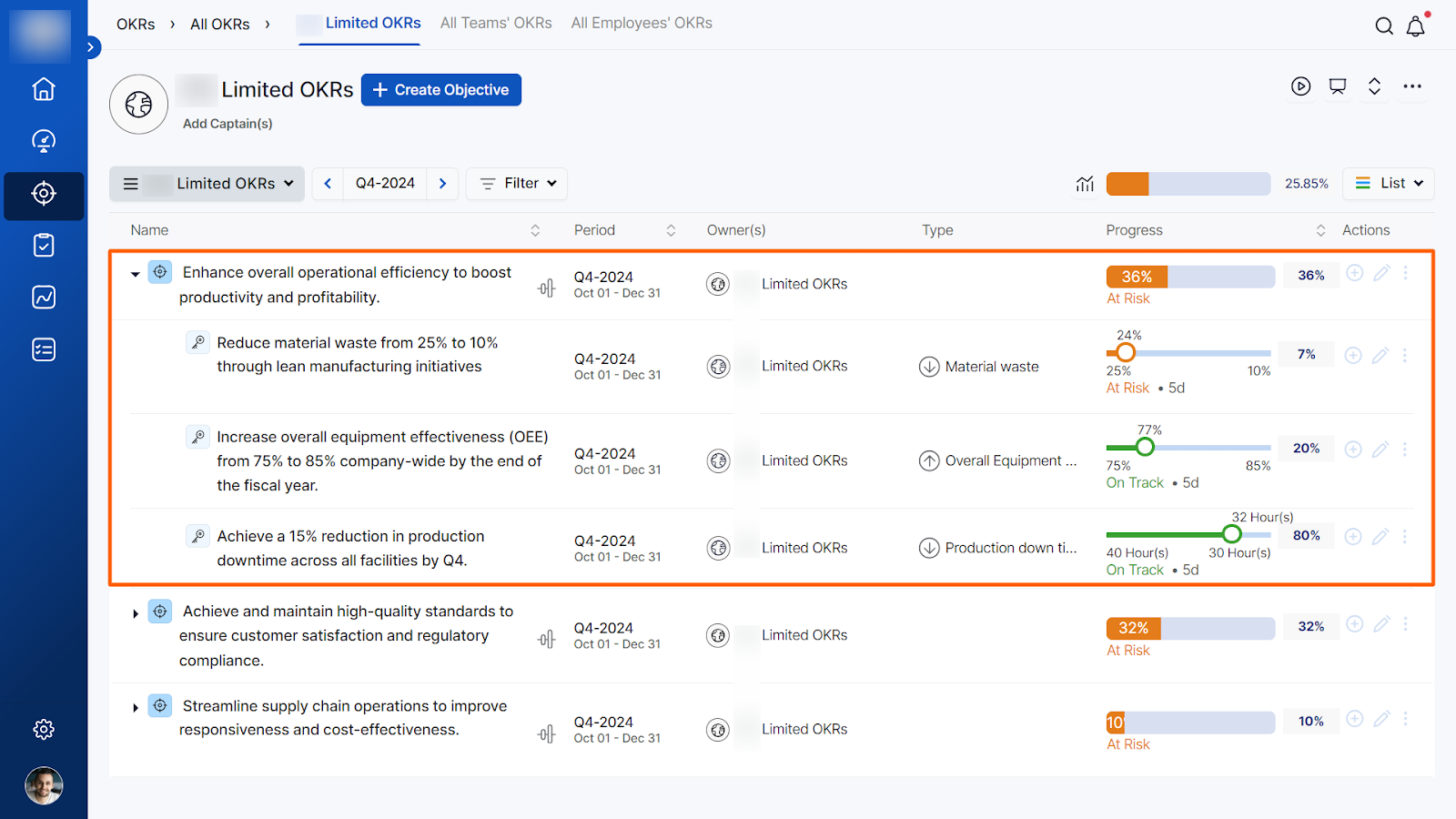
For example, as the above screenshot highlights, a company’s top objective is to enhance overall operational efficiency to boost productivity and profitability. This objective can be assigned as a key result to increasing overall equipment effectiveness (OEE) from 75% to 85%. This is a clear and trackable company-wide goal with an actionable key result for a manager. But how does this translate into actionable steps for a line operator?
Through OKRs, the line operator’s goal could be to reduce equipment downtime by a specific number of monthly hours. The sub-Key Results would measure this, ensuring every team member knows their part in achieving the bigger goal. This alignment boosts not only performance but also motivation.
2. Measurable Goals with Key Results
Performance management is data-driven in manufacturing, where every percentage point can affect the bottom line. OKRs help track outcomes through goals with measurable key results, ensuring everyone’s performance is tied to something tangible.
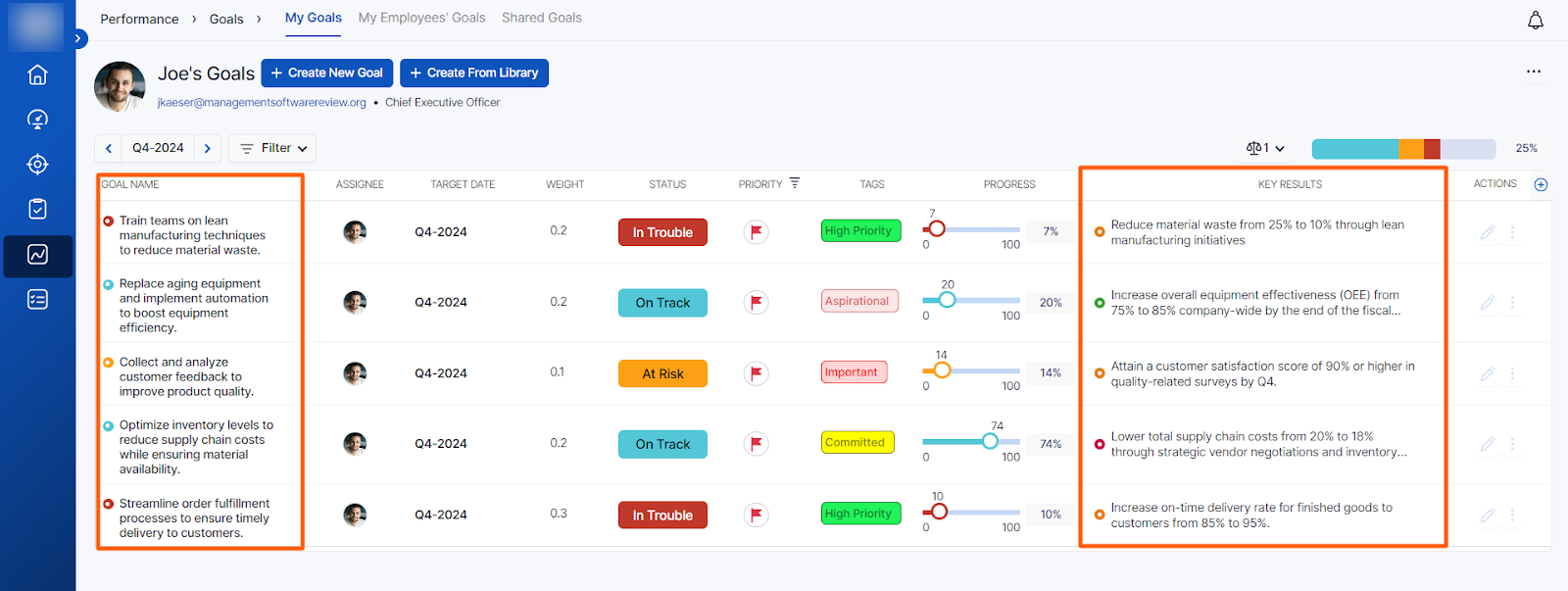
This screenshot presents an overview of Joe’s Goals for Q4-2024, showcasing his performance management dashboard and how it aligns with the OKR framework. Each listed goal represents Joe’s key focus areas and reflects strategic initiatives vital to the company’s overall success. This dashboard provides a real-time view of Joe’s progress toward achieving these goals.
Unlike traditional performance management systems, which rely heavily on quarterly or annual reviews, OKRs work in real-time. Employees can check their progress regularly and adjust their efforts accordingly, ensuring minor issues don’t become big problems.
This screenshot reflects the real-time benefits of using OKRs for performance management. A clear overview of each goal, progress tracking, and status alerts provide transparency into Joe’s performance and alignment with the company’s strategic objectives.
Ready to align your team’s goals with your company’s top objectives?
3. Linking Individual Goals with Company OKRs
How do OKRs help tie individual goals to larger company OKRs? This screenshot shows the goal of optimizing inventory levels to reduce supply chain costs while ensuring material availability. Tying this goal directly to the company’s broader cost-reduction and efficiency key result ensures that every effort made toward inventory management contributes to the business’s overall success. This alignment gives individuals like Joe Kaeser a clear understanding of how their work impacts the company, fostering greater ownership and commitment to achieving the goal.
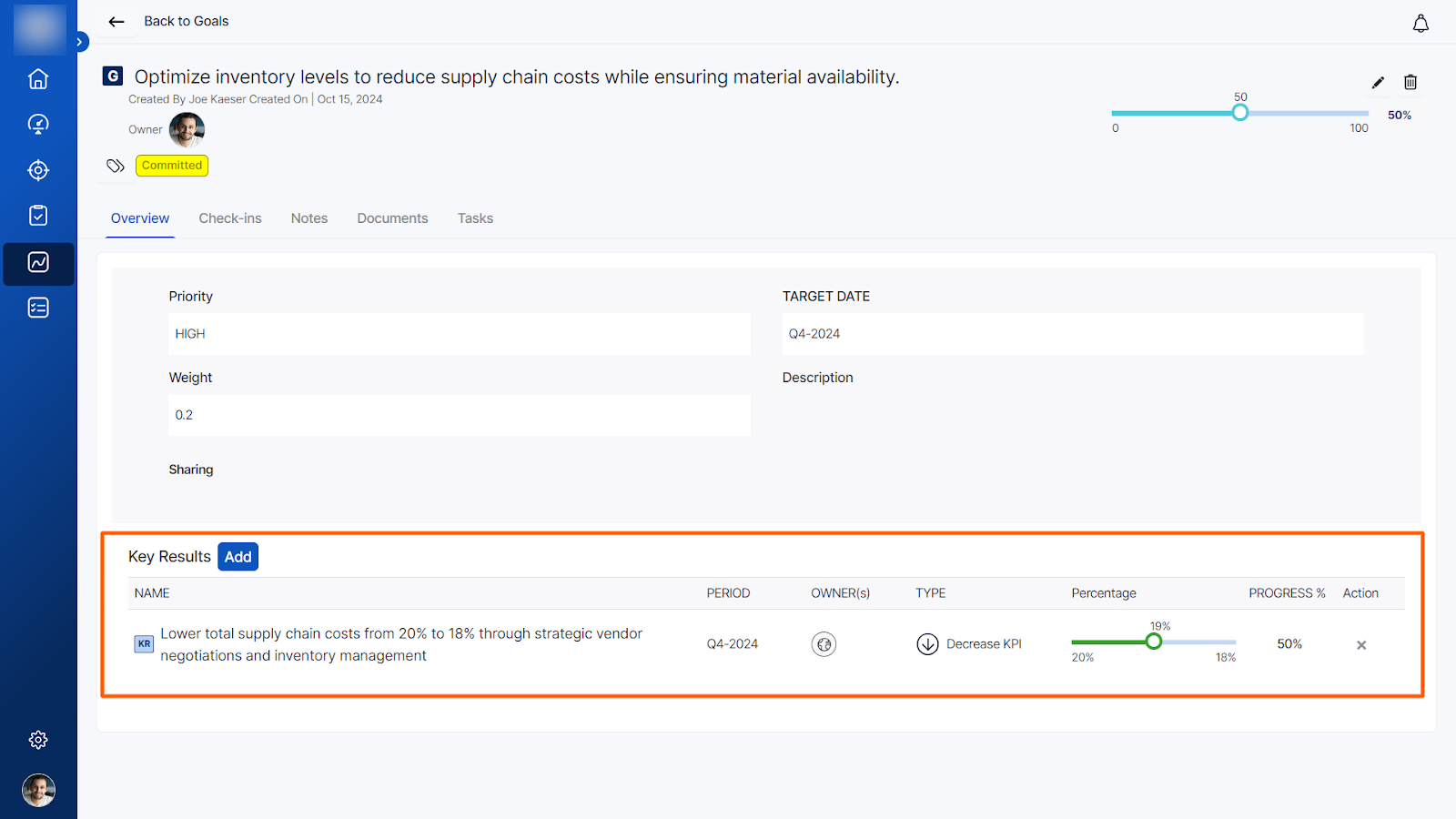
Let’s examine it in detail. Joe Kaeser is in charge of this high-priority goal, which is targeted for completion by Q4-2024. The key result is to lower total supply chain costs from 20% to 18% through strategic vendor negotiations and better inventory management.
Progress has been made, as indicated by the 19% completion. The system allows for continuous tracking and updates. The goal has a weight of 0.2, with high priority.
Joe Kaeser can see how his key result of lowering total supply chain costs from 20% to 18% is progressing. The data is updated in real-time, allowing him to pivot strategies if necessary, which is critical in manufacturing, where agility is key to staying competitive. This setup ensures Joe can keep a close eye on progress and take action when necessary, keeping the company on track to achieve cost reductions and improve efficiency in its supply chain.
4. Progress Tracking in real-time
This screenshot depicts a progress tracking dashboard for an OKR (Objectives and Key Results) system, specifically focusing on operational efficiency within a company. The key result is to increase overall equipment effectiveness (OEE) from 75% to 85% company-wide by the end of the fiscal year. Joe Kaeser, the individual responsible for this OKR, is making steady progress, as the green line indicates the progress is on track.
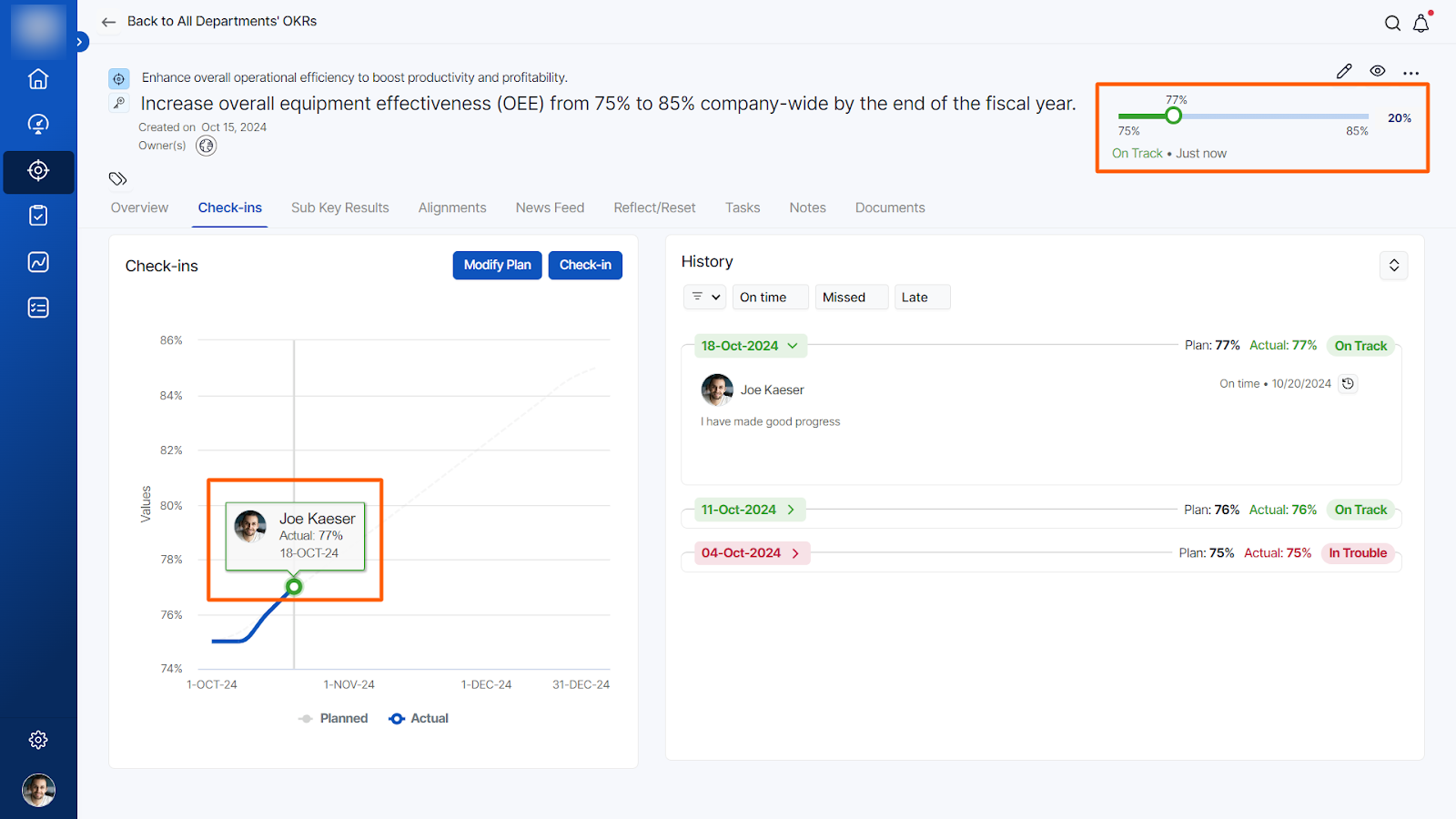
This screenshot demonstrates the real-time monitoring and accountability OKRs bring to performance management. With clear visual progress tracking, check-in history, and timely updates, teams can stay aligned with their goals and take action when needed. The system encourages consistent follow-up, ensuring everyone knows the current status and working towards the company’s broader operational goals.
5. Data Visualization Dashboards for Decision Making
In manufacturing, every decision—big or small—can significantly impact efficiency, output, and cost. This is where OKRs (Objectives and Key Results) shine by providing measurable insights that drive data-based decision-making. Unlike traditional methods that rely on periodic reviews or gut feelings, OKRs create a continuous loop of real-time data that allows managers to make smarter, faster choices.
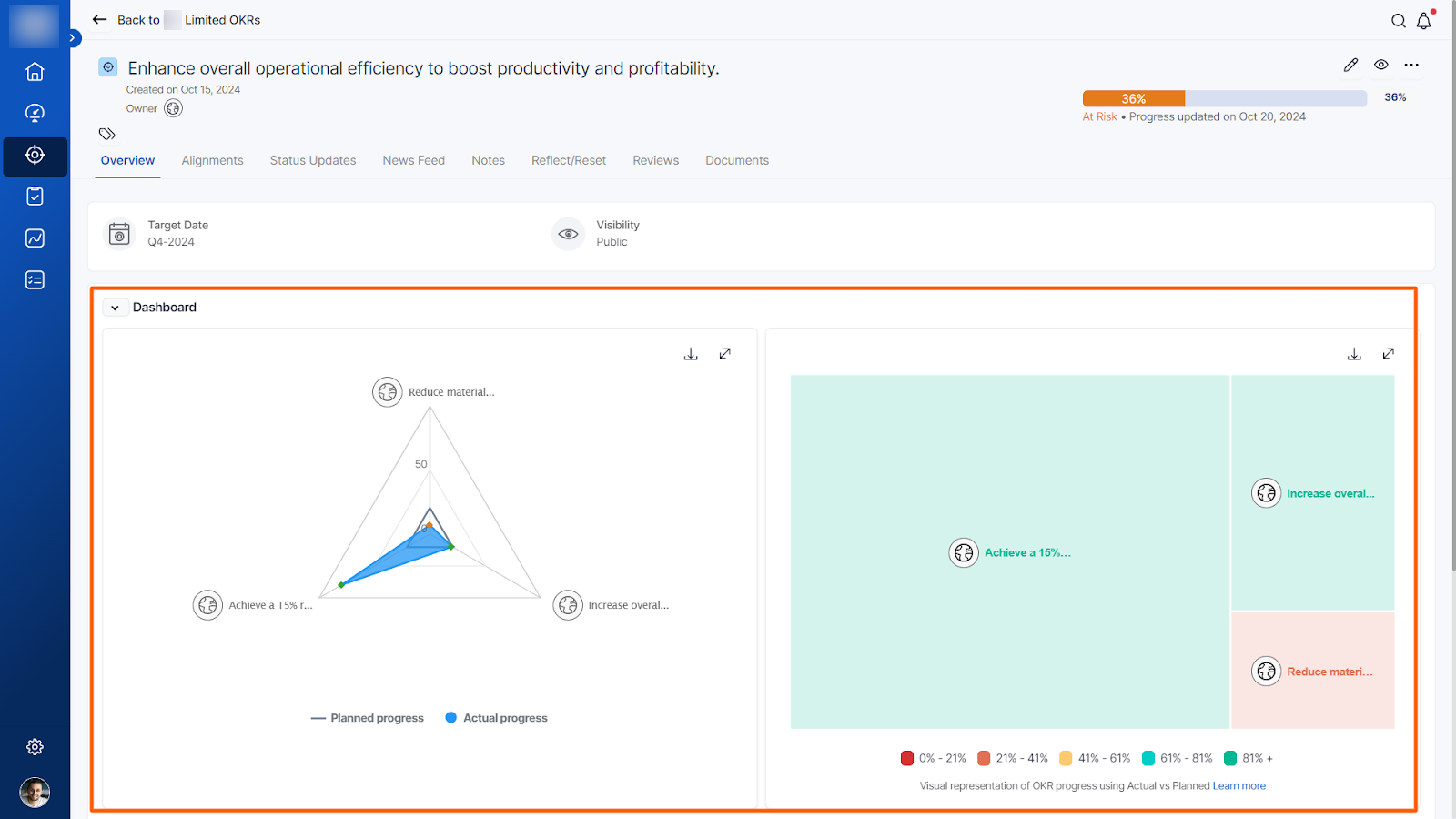
For example, Key Results might track machine downtime, production rates, or material waste on the shop floor. These numbers aren’t just abstract metrics; they are actionable data points that reveal what’s working and what needs immediate attention. With OKRs, a plant manager can instantly see if the equipment is operating below the target efficiency (like aiming for 85% OEE) and decide on quick interventions, such as scheduling preventive maintenance or reallocating resources to boost production.
The dashboard shows planned progress so teams can see their performance in real-time. With a progress bar indicating 36% completion and a status marked “At Risk,” it’s easy to see that while some areas, like increasing OEE, are moving forward, reducing material waste needs more focus.
Data-driven OKRs also help identify bottlenecks in the manufacturing process. If supply chain costs rise unexpectedly, OKRs linked to vendor negotiations or inventory management provide the clarity needed to investigate the issue further. By analyzing these key results, decision-makers can quickly pinpoint the problem areas—an underperforming vendor or inefficient inventory
levels—and make adjustments before costs spiral out of control.
Ultimately, data-driven OKRs ensure that decisions aren’t just reactive but proactive, turning real-time insights into actions that lead to cost savings, increased efficiency, and improved output across the manufacturing process.
But why exactly are OKRs such an excellent fit for the manufacturing industry?
OKRs (Objectives and Key Results) are a great way to set and track goals, and they work especially well in the manufacturing industry.
Why OKRs Are a Great Fit for Manufacturing
1. Clear Focus
OKRs help teams focus on what matters most by setting clear, strategic goals.
2. Measurable Progress
OKRs provide measurable results, allowing teams to track progress and adjust based on data.
3. Flexibility and Continuous Improvement
OKRs adapt to changing conditions, fostering a culture of continuous improvement.
4. Engaged Employees
OKRs boost transparency and motivation, ensuring employees know how their work contributes to the company’s success.
5. Strategic Alignment
OKRs ensure everyone—from leadership to line workers—is aligned with the company’s long-term goals.
Conclusion
In the manufacturing sector, where processes are complex and objectives must be crystal clear, OKRs provide a roadmap aligning individual efforts with company goals. By giving employees a clear sense of how their work impacts the big picture, OKRs foster a culture of accountability, transparency, and continuous improvement.
Research shows that employees with clear, aligned goals are more committed and motivated, making OKRs not just a performance management tool but a driver of success.




